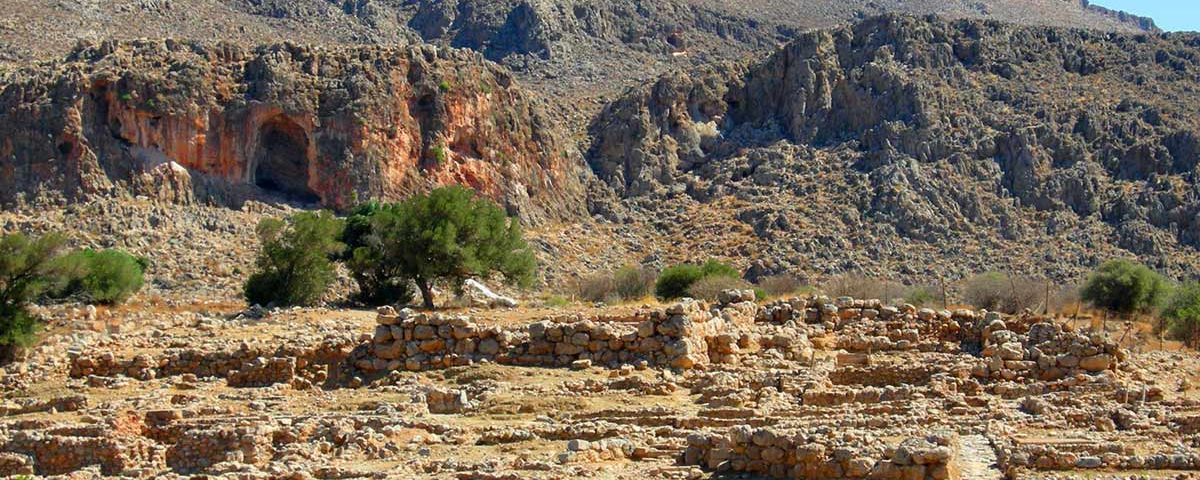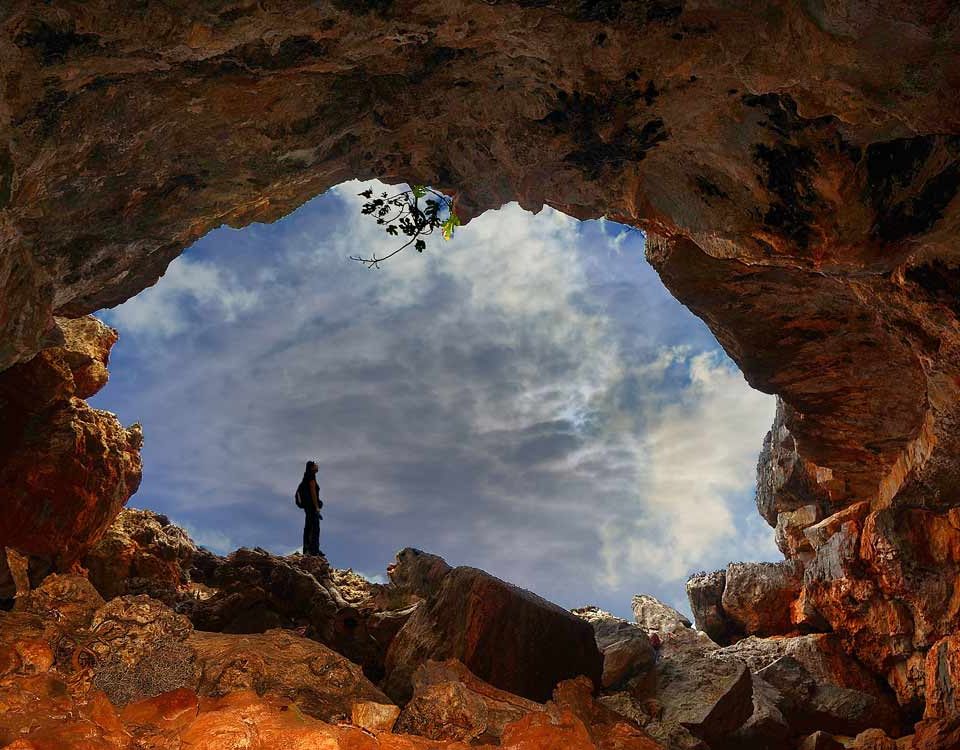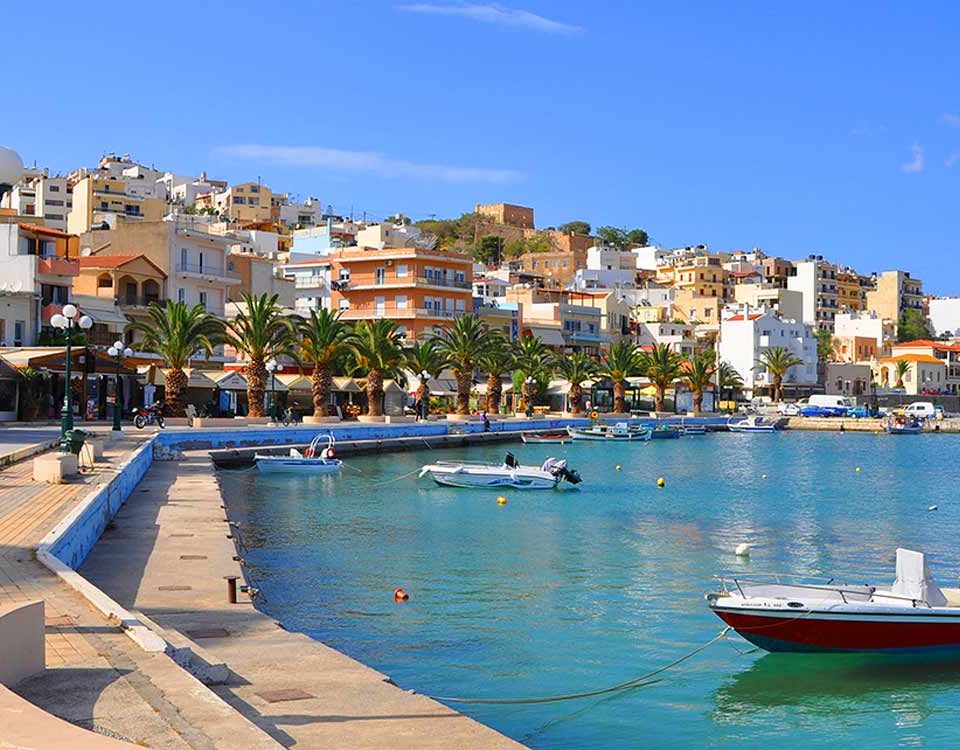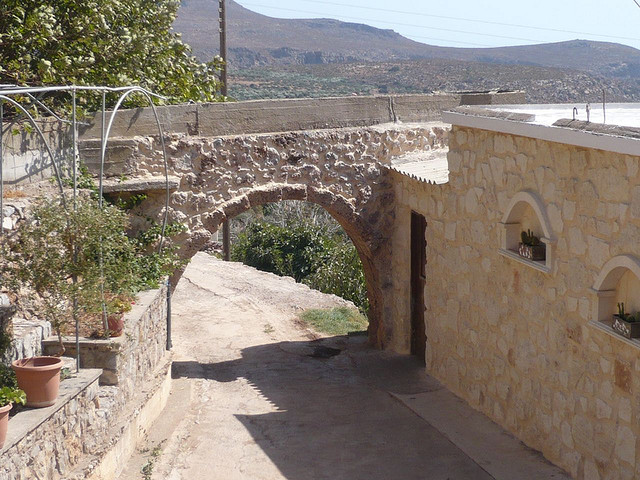- Contact Stella's Traditional:
- +30 28430 23739
- +30 6996523714
- stellasapts@gmail.com
Minoan Palace

Dead’s Gorge
January 22, 2023Three golden artefacts of great aesthetics and style, belonging to the collection of Dr Stelios Giamalakis, created to Nikolaos Platonas the conviction that the third Minoan palace of Crete lies buried in Kato Zakros. Nikolaos Platonas was not the first who believed in the existence of this Minoan Palace.
In the early 20th century, the English archaeologist David Hogarth brought to light a considerable number of Minoan buildings and clay imprints, suggesting that there has been harbouring and trading activity in the area.
The typhoon which hit the area in the summer of 1901(there is information that it uprooted 4000 trees), forced Hogarth to abandon the excavation urgently, having himself escaped drowning by miracle. Sixty years later, in October 1961, the excavations start again, under the man who was to bring the Minoan palace of Kato Zakros to light.
Nikolaos Platonas’ conviction, that a palace had to lie in the far eastern end of Crete, was based in ceramic finds of great aesthetics only an unknown royal workshop could produce.
The first excavation lasts only 10 days and was continued the next year with the financial support of the American Leo Pomerance and the Archaeological Society of Athens. 25000 km2 and 30 years of excavations brought to light a densely populated Minoan city with a highly developed road network, construction blocks and a palace equivalent to the ones of Malia, Faistos and Knossos. The finds, on the other hand, surpass, in number and quality, all the other archaeological finds in the previously mentioned palaces.
Nikolaos Platonas’ search of the Minoan cemetery ended in digging up many places in the wider area of Zakros. He believed that valuable scientific and historic finds could be dug up there. The search was spread over the whole length of the gorge that links Ano and Kato Zakros.
Inside many of the caves that exist in the walls of the gorge, tombs were found, but they were previous to the Minoan palace. A stone jewel-box was also found, which had a lying dog at its handle.
After the discovery of the tombs, Nikolaos Platonas himself named this gorge DEAD’S GORGE. The discovery of the palace added Zakros to the list of the Minoan government centres and formed a new viewpoint regarding the influence of the three known palaces. It also pointed out that, everywhere in Crete, a 5th or 6th Minoan palace could be hidden.
The happy coincidence, that, on the one hand, the palace was discovered by a scientist of highly theoretical grounding and experience, and, on the other after the discovery of the palaces of Faistos, Knossos and Malia, made the excavation more methodical and the recording more thorough.The palace of Zakros was found not looted and untouched by human hand (unlike the other 3 Minoan palaces). It was covered by earth, which blanketed it during the time of its violent distraction.
It is worth mentioning that minimum traces of the After-Minoan era were found during the excavation, which proves that the first human presence after the palace’s distraction, was the one of Nikolaos Platonas. In the palace’s unlooted treasury, artefacts of great aesthetics and artistic value were found, ceremonial pots and vessels, including the most beautiful stone vessel of the Cretan-Mycenaean era, a RITO (ceremonial vessel) made of clear Quartz. Moreover, various cups, goblets and urns made of rare material such as faience, ivory, obsidian, alabaster and veined marble, were also found.
The absence of human victims of the catastrophe points out the sudden abandonment of the palace. In the workshops, abandoned tools were found together with half processed material; in the fireplaces of the houses cooking pots together with crockery; in the temples libation vessels. An amazing find is a cup full of olives, which have maintained their flesh, because of the moisture of the soil, for over 3500 years. This cup was found inside a well in the central yard of the palace.
Plenty of indications convinced Nikolaos Platonas that the distraction of the palace occurred at the same time, and had obviously the same causes that generated the distraction of the other Minoan palaces: the eruption of the volcano of Thera. Many walls of the palace were uprooted from their foundations as if they were fiercely pushed from the East to the West.
Many earthenware jars were compressed on the western walls of the warehouses. Although the excavations in Thera, by Professor Spiros Marinatos, brought to light a prehistoric settlement earlier than the ones in Zakros, Nikolaos Platon supported the idea that there have been two eruptions of the same volcano. The first one, around 1500 B.C., destroyed the native civilisation of Thera and the second one, 50 years later, destroyed the Minoan civilisation.
The second eruption caused a tsunami, which hit Zakros and destroyed it. Although this version is controversial, it gains ground after the contemporary geological researches in Thera.
Although, theoretically speaking, the excavation of the palace has been completed, the huge work of the recording and the evaluation of the finds remains to be done. This work is as big and complicated as the excavation itself.
Unfortunately, Nikolaos Platon, the most suitable person to record and evaluate the finds, died at the age of 82. However, before his death he founded the “Publication of the Excavation of Zakros Team”. This team is called upon to evaluate about 12000 pots, vases and vessels, 1100 chests full of pottery and thousands of other small objects worth recording.
This research as well as the detailed imprinting of the architecture and of the objects is expected to give answers to historical, cultural and chronological questions about the prehistoric inhabitants of Zakros.
Head of the maintenance and publication of the finds of the excavation of Zakros is the son of Nikolaos Platonas, Lefteris, Dr of prehistoric Archaeology of the University of Bristol. He is a gentle young man and he can be found, together with his small archaeological team, in Kato Zakros almost every summer. There he can get eager information about the history of the place and the continuing archaeological research.




